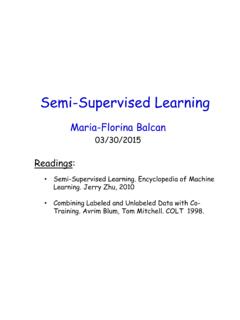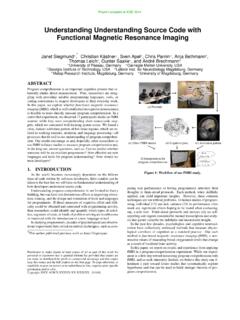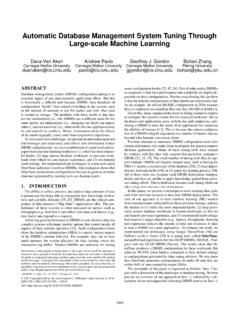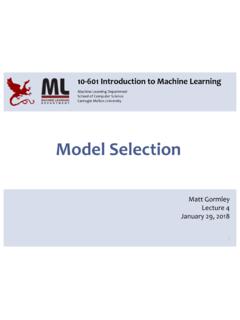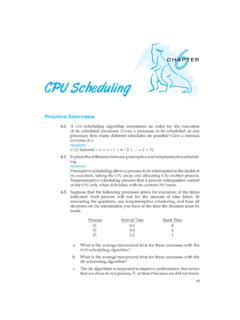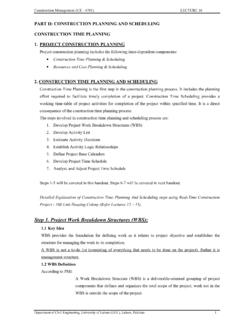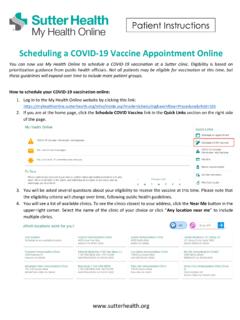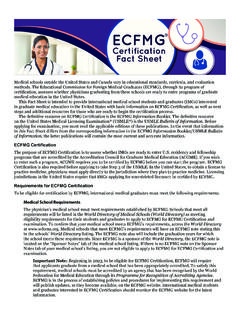Transcription of Objectives Project planning and scheduling
1 Page 1 Version Carnegie Mellon, 20051 Project planning and scheduling Project PlanningMel Carnegie Mellon, Project the stages of Project planning : Scoping Estimation Risk Analysis on some of the tools and techniques available to a Project plannerVersion Carnegie Mellon, 20053 Topics planning Estimation of tasks Cost and time planning and risk scheduling and why projects are late scheduling and planning tools Project trackingVersion Carnegie Mellon, 20054 Software Project planning Goal is to establish a pragmatic strategy for controlling, tracking, and monitoring a complex technical Project Must deal with: Project complexity: has a strong effect but is heavily influenced by past practitioner experience Project size: as size increases the interdependency of elements also grows.
2 Watch out for scope creep (when customers change requirements mid-cycle) The degree of structural uncertainty: the degree to which requirements are solidified and the ease of functional decomposition The purpose of Project planning is to ensure that the end result is completed on time, within budget, and exhibits quality!Version Carnegie Mellon, 20055 Steps in Project planning Scope understand the problem and the work that must be done. Estimation how much effort? how much time? Risk what can go wrong? how can we avoid it? what can we do about it? Schedule how do we allocate resources along the timeline? what are the milestones? Control strategy how do we control quality?
3 How do we control change?SoftwareProjectPlanProject ScopeEstimatesRisksScheduleControl strategyVersion Carnegie Mellon, 20056 Scope A bounded description of the data and control, function, performance, constraints, interfaces and reliability Sufficient to determine Project feasibility and create an initial plan Scoping Techniques: FAST (Facilitated Application Specification Technique), QFD (Quality Function Deployment), Use-Cases Scope is affected by: Customers needs Business context Project boundaries Customers motivation Likely paths for changePage 2 Version Carnegie Mellon, 20057 Estimating Resources Human Resources: Select skills required (both position and specialty, database software engineer).
4 Requires an effort estimate Reusable Software Resources: Off-the-shelf components (existing software acquired from 3rdparty with no modification required) Full-experience components (previous Project code is similar and team members have full experience in this application area) Partial-experience components (existing Project code is related but requires substantial modification and team has limited experience in the application area) New components (must be built from scratch for this Project )Version Carnegie Mellon, 20058 Estimating Resources - 2 Environmental Resources: The hardware and software tools required to develop the Project . Planner needs to provide a time window for booking themVersion Carnegie Mellon, 20059 Estimating Cost and Effort Project scope must be explicitly defined.
5 If not, the Project may be infeasible Task and/or functional decomposition is necessary Historical measures (metrics) are very helpful Triangulation: At least two different techniques should be used. Can be reconciled if they are within 20% Remember that uncertainty is inherent in early estimates Viable estimation until later in the Project (XP approach) estimates on similar projects that have already been relatively simple decomposition techniques (LOC or FP)Version Carnegie Mellon, 200510 Risk Analysis and Management Definition of Software Risk: Concerns future happenings. What risks might cause the Project to go astray? Involves change. How will changes in customer requirements, development technologies, target computers, and other entities affect timeliness and success?
6 Requires choice. What methods and tools should be used, how many people should be involved to reduce risk?Version Carnegie Mellon, 200511 Risk Analysis and Management-2 Questions: What can go wrong? What is the likelihood? What will the damage be? What can we do about it?Version Carnegie Mellon, 200512 RISKRisk Management Paradigmcontrolcontrolidentifyidentifyan alyzeanalyzeplanplantracktrackPage 3 Version Carnegie Mellon, 200513 Risk (3xM) Mitigation, Monitoring,and Management Mitigation how can we avoid the risk? Monitoring what factors can we track that will enable us to determine if the risk is becoming more or less likely? Management what contingency plans do we have if the risk occurs?
7 Version Carnegie Mellon, 200514 scheduling I love deadlines. I love the whooshing sound they make as they fly by. Douglas Adams The Schedule connects the scope, work estimates and deadline into a network of SE tasks Must Manage: Parallelism (tasks can be undertaken simultaneously) Dependency (task has an effect on subsequent tasks) Bad scheduling is a very destructive influence 90-90 Rule: First 90% of a Project is complete in 90% of the scheduled time. The other 10% is also completed in 90% of the timeVersion Carnegie Mellon, 200515 Why Are Projects Late? An unrealistic deadline established by outsiders Changing customer requirements that are not reflected in the schedule An honest underestimate of effort and/or resources required Risks that were not considered when the Project startedVersion Carnegie Mellon, 200516 Why Are Projects Late?
8 - 2 Technical difficulties that could not have been foreseen Human difficulties that could not have been foreseen Miscommunication among Project staff Project management failing to recognize schedule slippage and not taking corrective actionVersion Carnegie Mellon, 200517 Dealing with Unrealistic Deadlines Any commander in chief who undertakes to carry out a plan which he considers defective is at fault; he must put forth his reasons, insist on the plan being changed, and finally tender his resignation rather than be the instrument of his army s downfall. NapoleonVersion Carnegie Mellon, 200518 Tools and techniques for the planner scheduling PERT Program Evaluation and Review Technique Work Breakdown Structure (WBS) Gantt Chart Named after Henry Grant ETVX How do you track tasksPage 4 Version Carnegie Mellon, 200519 scheduling Program Evaluation and Review Technique (PERT) AKA Critical Path Method (CPM) is a Project scheduling method that determines.
9 Critical Path (the chain of tasks that determine the duration of the Project ) Earliest Time that a task can begin if all preceding tasks are completed in the shortest possible time Latest Time for task initiation that will not delay the Project Latest and Earliest Finish for the overall Project Total Float (the maximum slippage without overall delay) Implementation: Automated tools Often use a task network as inputDefine a Task Network Task (Activity) Network: a graphical representation of the task flow and interdependencies for a Concept Concept Risk Risk Risk Concept Concept a, b, Customer Concept Concept Carnegie Mellon, 200521 WBS Work break down structure What has to be done to complete the Project All the tasks in the Divide and conquer of the problem Granularity equals level of WBS First level, high level tasks Second level are those task that complete the first level Very similar to Outline for a paperVersion Carnegie Mellon, 200522 Gantt chart A Gantt chart provides a graphical illustration of a schedule that helps to plan, coordinate.
10 And track specific tasks in a Project developed in 1917 by Henry L. Gantt A Gantt chart is constructed with a horizontal axis representing the total time span of the Project , broken down into increments (for example, days, weeks, or months) and a vertical axis representing the tasks that make up the Project Gantt Identify need and benefits Meet with customers Identify needs and Project constraints Establish product statement Milestone: product statement Define desired output/control/input (OCI) Scope keyboard functions Scope voice input functions Scope modes of interaction Scope document diagnostics Scope other WP functions Document OCI FT R: Review OCI with customer Revise OCI as required; Milestone.

